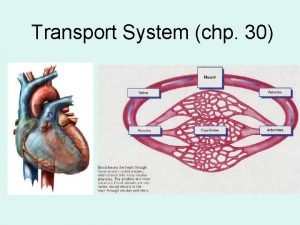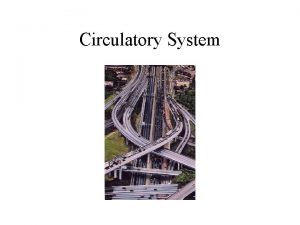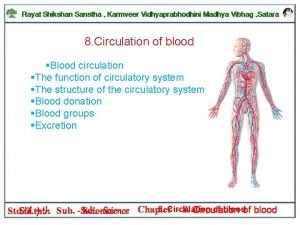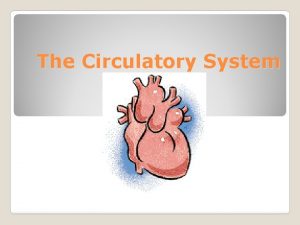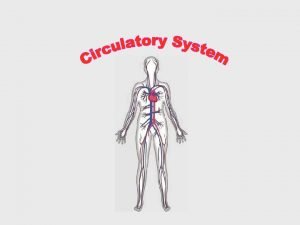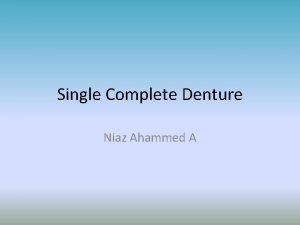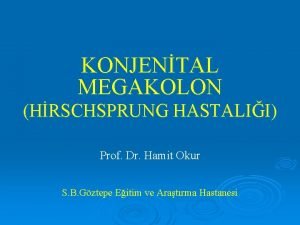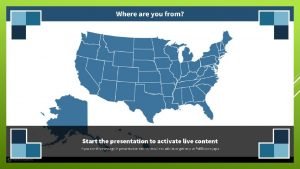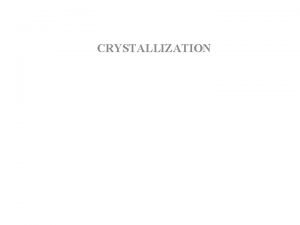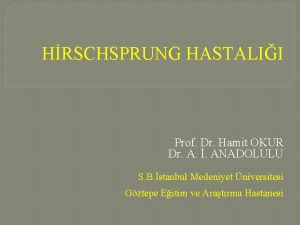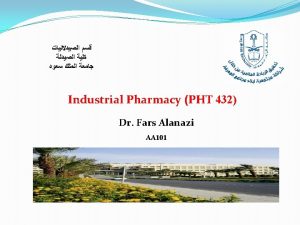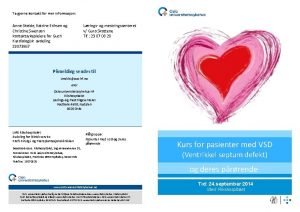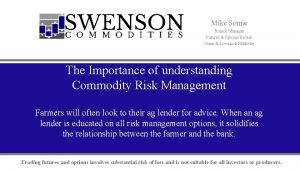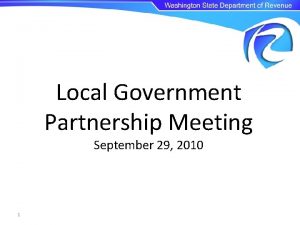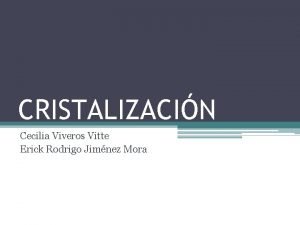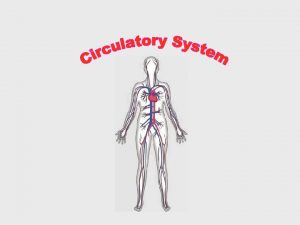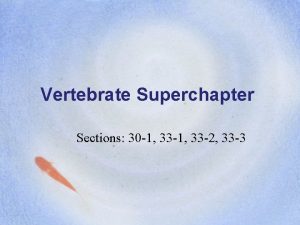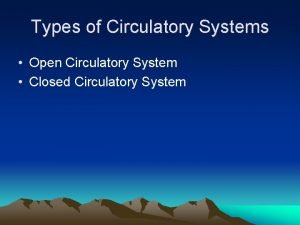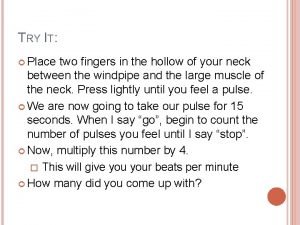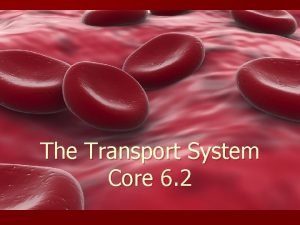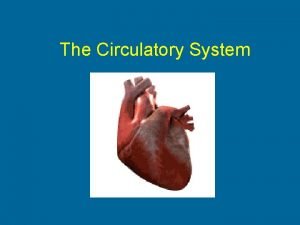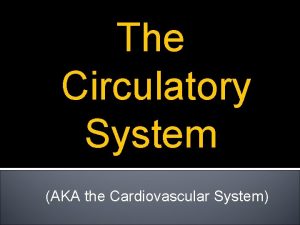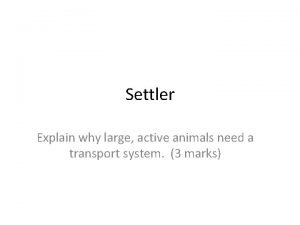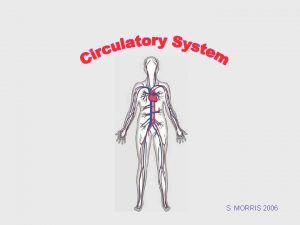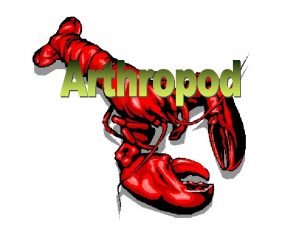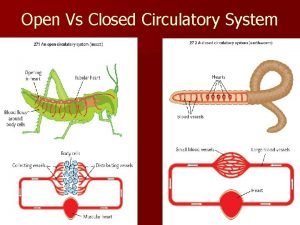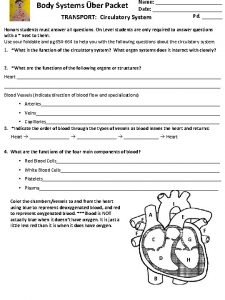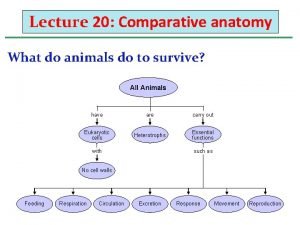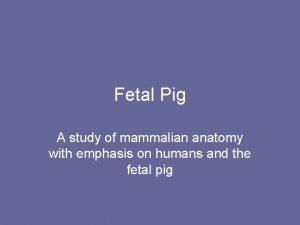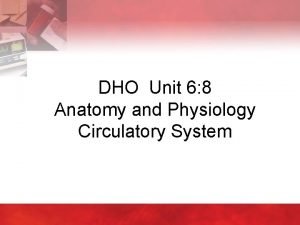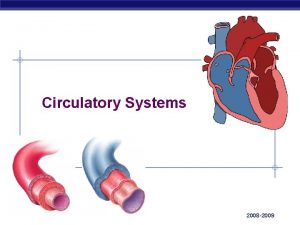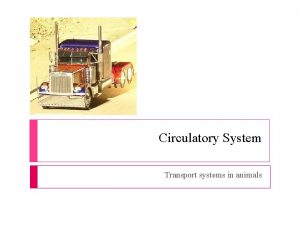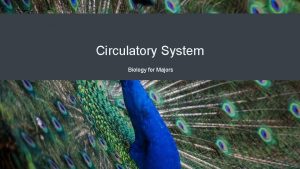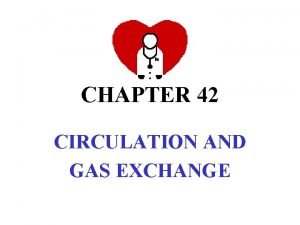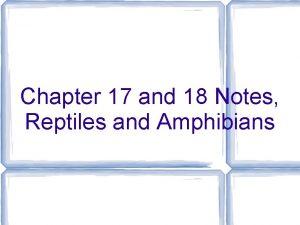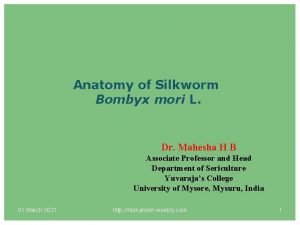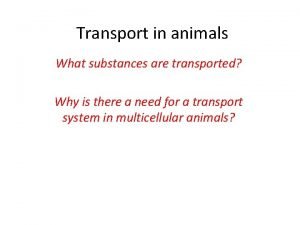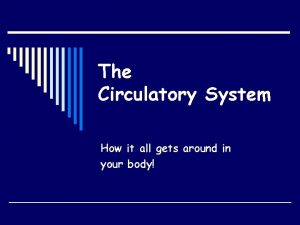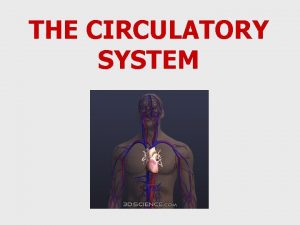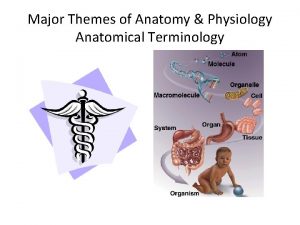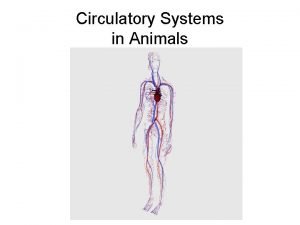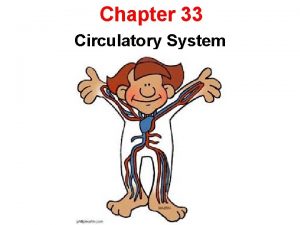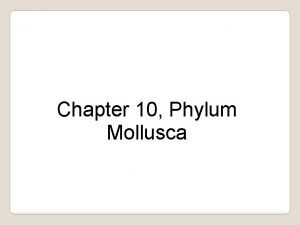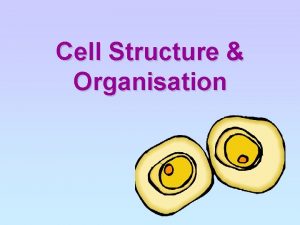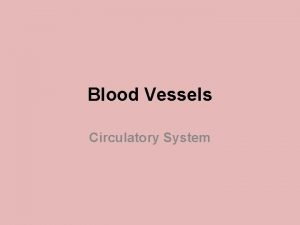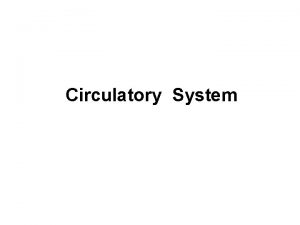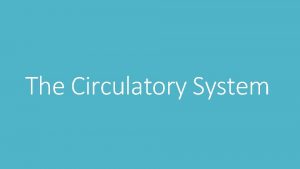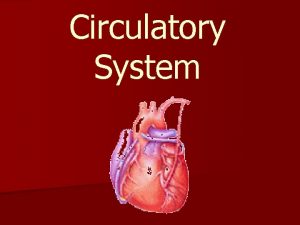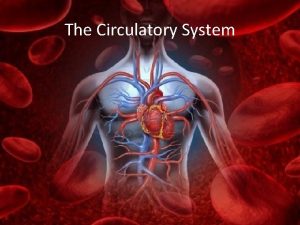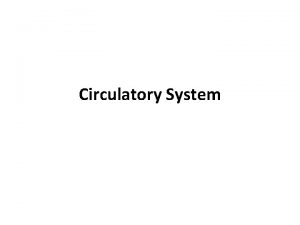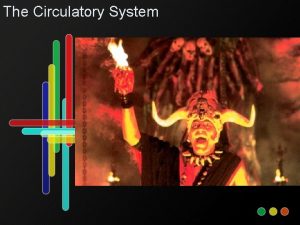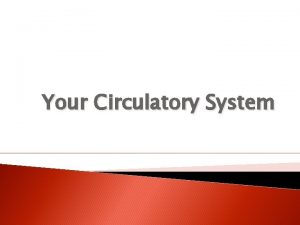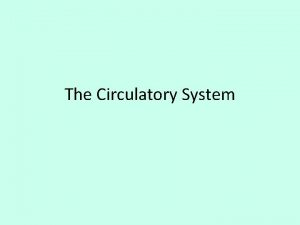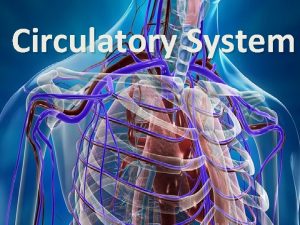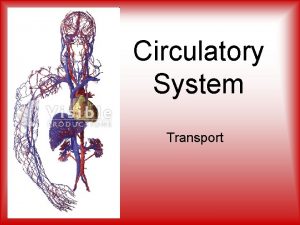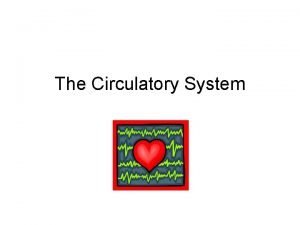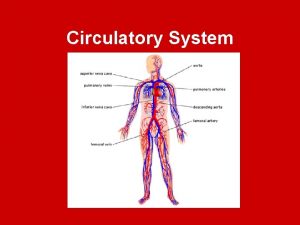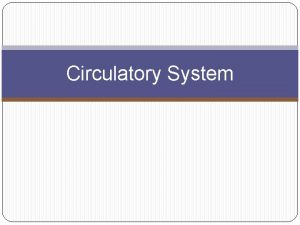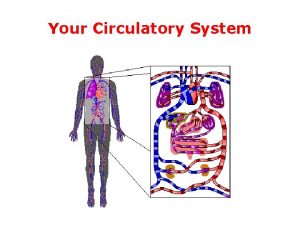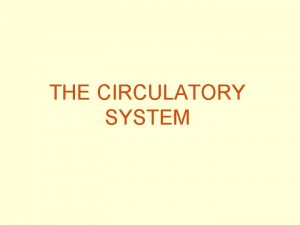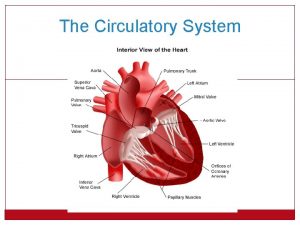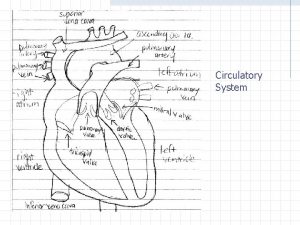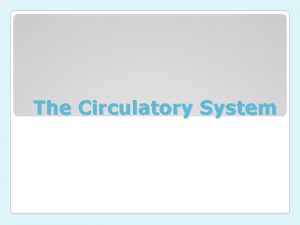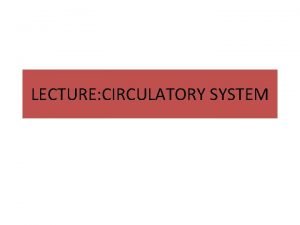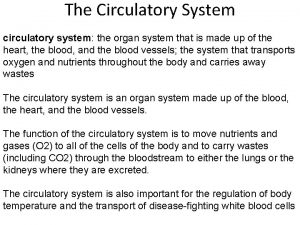Transport Swenson Circulatory system Function of Circulatory System

































































- Slides: 65

Transport Swenson

Circulatory system Function of Circulatory System § Food and Oxygen (O 2) to cells § Temperature control § Hormone delivery § Remove wastes away from cell § Maintain Water balance § p. H balance § Blood Clotting § Immune system

Quantity of blood in adults 5 -6 L Blood components video: http: //health. howstuffworks. com/human- body/systems/circulatory/adam-200081. htm

Componenets of blood Plasma • Functions: CO 2 transport, wastes, nutrients. • Made of: 90% water, 7% protein, 3% minerals (Na+, K+, I 2, Fe+3), gases (O 2, CO 2), wastes.

– “Buffy coat” leukocytes (white blood cells) § Made of immune cells + platelets

n Erythrocytes – red blood cells (carry O 2)

Red Blood Cell Function: v Carry O 2 to cells v Remove CO 2, as HCO 3+ from cells. Characteristics: v Red-hemoglobin (Fe) v No nucleus v 100 -120 day life span v Made in bone marrow v Old cells removed in liver and spleen v Hemoglobin binds CO tighter than O 2

White Blood Cell Function: n Defend against invaders Characteristics: n Large nucleus n Made in bone marrow. n Respond where needed. n 1 WBC to 600 RBC n Life: 3 days n Can attack YOU (allergies, arthritis)

Platelets Function: n Blood Clotting Characteristics: § Odd shape § Smallest blood celll § No nucleus § 20: 1 RBC: platelets Red blood cell, platelet and white blood cell

Blood Vessels n Video http: //www. youtube. com/watch? v=Cj. NKb L_-cw. A&feature=related

Arteries – n n Arteries “A” away Blood away from heart Oxygen rich Elastic and has pulse Can be clogged with cholesterol

Veins Back to heart n 1 way valves n Not as flexible as arteries - contractions n close to surface of the skin n

Capillaries Connect arteries to veins n Small (some walls 1 cell thick) and not flexible n Gas and nutrient/waste exchange happens here: In: food, O 2 and H 2 O n Out: CO 2 and wastes


Hepatic Artery

Radial vein Ulnar Vein

Problems with Circulatory Anemia – What is it? § Low RBC count. What is the cause of it? RBC’s do not live full life span. Thus, bone marrow cannot keep up. Or WBC’s mistake RBC’s foreign invader. Hemoglobin is an iron rich protein. Not same thing as anemia this is called Irondeficient anemia

Symptoms: Tired, fatigued, rapid heartbeat, dizziness, pale skin, leg pain, etc. Treatments: Vitamin B 12 supplement, increase in iron

II. Leukemia What is it? Abnormal white blood cells n (4 major types) cancer of blood forming tissue What is the cause of it? - Bone marrow has increase of production of white blood cells

n Symptoms: fatigue, abnormal bleeding, weight loss, exercise intolerance, infection/fever, abdominal pain, enlarged spleen/lymph nodes or liver n Treatments: chemotherapy (chemicals to kill), Radiation therapy (X-ray’s to damage cells), Biological therapy (help immune system recognize and kill cells)

III. Hemophilia What is it? Lack of blood clotting factors What is the Cause? Inherited a faulty gene Symptoms: Prolonged bleeding, easy bruising, nosebleeds, swelling/inflammation of muscles Treatments: Replacement therapy where blood clotting factors are placed in the blood intravenously.

Blood Information n Coagulation is blood clotting How it works: http: //www. mhhe. com/biosci/esp/2002_general/Esp/folder_structure/tr/m 1/s 7/trm 1 s 7_3. htm


Stroke What is it? Lack of supply of oxygen to the brain What is the cause? caused by an embolism to the brain which blocks blood flow (oxygen) animation http: //health. howstuffworks. com/adam-200071. htm

Varicose Veins What is it? Enlarged veins What is the Cause? 1. defective/damaged valves within the veins that allow blood to build up. 2. This pooling expands veins causes them to enlarge

n Symptoms: veins that are dark blue in color, bulging or pain in the legs, n Treatments: Compression stockings, Sclerotherapy where doctor injects a solution into veins that scars them, closing those veins or Laser surgery where bursts of light close veins (no needles)

IV. Bruises -the muscle fibers and connective tissue underneath are crushed. Then blood from the ruptured capillaries near the skin's surface escapes and leaks where the blood gets trapped

Heart Lecture I. Heart’s purpose n Pump blood to body. II. Pericardium n Sack around heart to lubricate. III. How many chambers in a human heart? 4 chambers – 2 atriums (upper) – 2 ventricles (lower) Purpose is to provide one directional flow of blood through the heart

Flow through heart n Use overhead to go through heart parts and function n http: //health. howstuffworks. com/adam 200083. htm

Right side n n n Superior and Inferior vena cava - largest veins in your body and carry the oxygen-poor blood back to the right atrium of your heart. Right atrium - receives the blood and then pumps to the right ventricle. Right ventricle – pumps blood through semilunar valve to the pulmonary arteries to your lungs. Pulmonary arteries – pump oxygen poor blood to thin blood vessels called capillaries, the blood picks up more oxygen. Pulmonary veins - pump oxygen-rich blood from your lungs back to the LEFT side of the heart

Left Side Blood from Pulmonary veins enters the left atrium. n Left Atrium – pumps blood into the left ventricle n n Left ventricle - oxygen-rich blood is pumped through n Like all of your organs, your heart needs blood rich with oxygen. This oxygen is supplied through the coronary arteries as blood is pumped out of your heart's left ventricle. the semilunar (aortic valve) to your aorta and to the rest of the body.

Valves – prevent backflow n Tricuspid valve – right side of the heart between atrium and ventricle n Bicuspid valve – left side of the heart between the atrium and ventricle n Semilunar Valve (pulmonic or aortic) – away from heart to lungs or away from heart to the body

n Septum Tissue that separates the left from the right side of the heart.

Which heart parts and closely related blood vessels high in CO 2? (color green) n Sup/Inf. Vena cava, pulmonary artery, right atrium, right Ventricle Which heart parts and closely related blood vessels high in O 2? (color red) n Left atrium and Lft. Ventricle, Pulmonary vein, Aorta


Heart Beat n What controls the heart beat? Natural Pacemaker called the Sinoatrial Node (S. A. Node) 1. The SA node sends electrical impulses from the top chamber of the heart (Atrium) 2. Then the atrium contracts (presses together - squeezes) and sends blood to the bottom chamber (Ventricle)

3. Then the electrical impulses are in the ventricles through a node called AV node (Atrioventricular node) - the 2 nd node that sends electrical impulses after the SA node 4. So the impulse spreads throughout the ventricles (right & left), the muscles contract and then pump out blood 5. Blood from the right ventricle goes to your lungs & blood from the left ventricle goes to your whole body. http: //highered. mcgrawhill. com/sites/0072495855/student_view 0/chapter 22/animation__conducting_ system_of_the_heart. html


What is blood pressure? Pressure of blood on arteries. – Systole is ventricles contracting, the “beat” (first pressure number measured) – Diastole is ventricles relaxed “resting” (second pressure number)


Blood pressure indicates how well the heart is pumping BP should be: 120/80


What affects blood pressure? • Age, diet, can increase systole. • Exercise can decrease diastole • Cigarettes increase

Problems?

Pulse What is your pulse? n The number of beats/minute through your arteries. (use of thumb) n Adults about 70 beats per minute What affects the heart rate? n Decreases with age, regular exercise, Temperature, and hormones also affect heart rate. n Cigarettes increase heart rate.

How can you measure pulse? A. Carotid artery (neck) B. Radial artery (wrist) n When you measure your pulse, what do you actually feel? Feeling pressure on the arteries from the ventricles contracting, pushing blood through

High blood pressure n Increase pressure on arteries and veins causing heart to work harder to pump blood “High blood pressure -- 50, 000. ” (http: //www. americanheart. org/presenter. jhtml? identifier=4591) II. Artheriosclerosis -hardening and clogging of arteries that reduces elasticity

Plant Transport Definition of vascular tissue n Transport tissue, in plants H 2 O or nutrients Types of vascular tissue A. Xylem - Dead cell walls, form “pipes” to carry water. n Water flows generally from roots to leaves. B. Phloem - Live cell “tubes” transport sap. (nutrients) n Sap flows up, down and across

Materials transported Transported in Xylem H 2 O Dissolved minerals (Mg+2, Mn+6, K+, etc. ) Hormones

How does Xylem Work? I. Successive Osmosis – The flow of water from a high concentration to a low concentration, through several cells into the root. II. Cohesion of water molecules -- Hydrogen bonds in water cause water to “stick” together because of attraction between like molecules. This is why droplets form. III. Adhesion of water molecules The force of attraction between unlike molecules n Cohesion and Adhesion are the forces that allows water to rise up the xylem.

IV. Transpiration -- Water loss through the stomata in the leaves. This water loss causes the rise of water through the xylem from the roots. § more than 90% of water absorbed is released by leaves. – Ex. Tomato plant 25 gallons per season, corn plant 51 gallons.


Transported in Phloem Oxygen Sucrose (sugar) Horomones Water n

How Does Phloem Work? I. Pressure Flow Hypothesis (Translocation) At the leaves (source) - sugars are pumped by active transport to the sieve tubes of the phloem. -- Water containing the sugar molecules flows under pressure created by the difference in water concentration between phloem and xylem.


Turgor Pressure - Water flowing toward solutes in the leaves. This pressure stands plants up. “wilting” is lack of pressure. Pressure builds up in the sieve tubes The pressure gradient between "source" (leaves) and "sink" (shoot and roots) drives the contents of the phloem up and down through the sieve tubes.

n Herbaceous stem – are green and fairly bendable Woody Stem – covered by bark are

Girdling n Tree girdling occurs when a strip of bark around a tree's circumference is removed.

n Why is the fluid sweet? Trees use their bark to transport nutrients – sap (sugar). n End Result? When a strip of bark is removed, the tree cannot move certain nutrients up and down This will cause the death for the tree.

Monocot vs. Dicot

Monocot stem

Dicot Stem


Dicot root Looks like a plus sign

Cortex – stores starch n Epidermis - skin n Root hairs increase surface area for absorption n Vascular Cambium – produces phloem and xylem through process of mitosis n
 Circularory system
Circularory system Carbon dioxide levels in the blood
Carbon dioxide levels in the blood Main function of the circulatory system
Main function of the circulatory system Function of the circulatory system
Function of the circulatory system Function of the circulatory system
Function of the circulatory system Function a
Function a Circulatory system function
Circulatory system function Single complete denture
Single complete denture Swenson ameliyatı
Swenson ameliyatı Shane swenson
Shane swenson Supersaturation definition
Supersaturation definition Prof dr hamit okur
Prof dr hamit okur Wulff-bock crystallizer
Wulff-bock crystallizer Christine swenson
Christine swenson Swenson commodities
Swenson commodities Eric swenson net worth
Eric swenson net worth Tipos de cristalizadores
Tipos de cristalizadores Primary vs secondary active transport
Primary vs secondary active transport Membrane structures that function in active transport
Membrane structures that function in active transport Now answer the following questions
Now answer the following questions Active vs passive transport venn diagram
Active vs passive transport venn diagram Unlike passive transport active transport requires
Unlike passive transport active transport requires Primary active transport vs secondary active transport
Primary active transport vs secondary active transport Bioflix activity membrane transport active transport
Bioflix activity membrane transport active transport Active and passive transport
Active and passive transport Bioflix membrane transport
Bioflix membrane transport How respiratory system work with circulatory system
How respiratory system work with circulatory system Circulatory system and respiratory system work together
Circulatory system and respiratory system work together Circulatory system steps in order
Circulatory system steps in order Non vertebrate
Non vertebrate Heart fish
Heart fish Do clams have open or closed circulatory systems
Do clams have open or closed circulatory systems Horse heart
Horse heart Closed circulatory system
Closed circulatory system Jobs of circulatory system
Jobs of circulatory system 3 main parts of circulatory system
3 main parts of circulatory system Double circulatory system
Double circulatory system How circulatory system work
How circulatory system work What makes up the cardiovascular system
What makes up the cardiovascular system The actual exchange of gases occurs at the site of the
The actual exchange of gases occurs at the site of the Single vs double circulatory system
Single vs double circulatory system Arthropods respiratory system
Arthropods respiratory system Crustaceans characteristics
Crustaceans characteristics Open circulatory system vs closed
Open circulatory system vs closed Circulatory system foldable
Circulatory system foldable Invertebrate circulatory system
Invertebrate circulatory system Fetal pig circulatory system
Fetal pig circulatory system Unit 6:8 circulatory system
Unit 6:8 circulatory system Open circulatory system
Open circulatory system Invertebrate circulatory system
Invertebrate circulatory system Arthropods circulatory system
Arthropods circulatory system Difference between open and closed circulatory system
Difference between open and closed circulatory system Chapter 34 circulation in humans concept mapping answer key
Chapter 34 circulation in humans concept mapping answer key Vomeronasal organ snakes
Vomeronasal organ snakes Digestive system of silkworm diagram
Digestive system of silkworm diagram Open circulatory system vs closed
Open circulatory system vs closed Circulatory system interactions with other systems
Circulatory system interactions with other systems Where are the capillaries located in the circulatory system
Where are the capillaries located in the circulatory system Blood vesel
Blood vesel Circulatory system
Circulatory system Mouth function in digestion
Mouth function in digestion Reptile circulatory system
Reptile circulatory system Chapter 33 section 1 the circulatory system
Chapter 33 section 1 the circulatory system Mollusk characteristics
Mollusk characteristics Root hair cells
Root hair cells Blood vessels circulatory system
Blood vessels circulatory system

